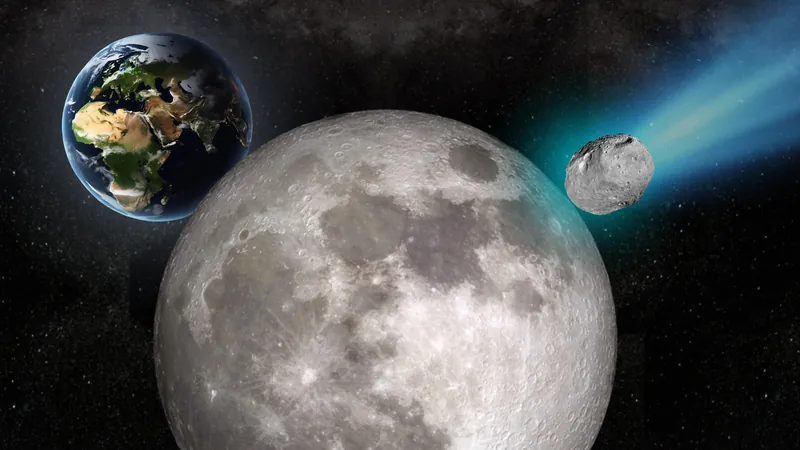
Asteroid 2024 YR4: It Won't Hit Us, But Here's Why It Could Cause a Stir!
2025-07-11
Author: Arjun
Asteroid 2024 YR4 might not pose a direct threat to Earth anymore, but this colossal 200-foot-wide rock still has the potential to mess with our lives in ways you wouldn't expect.
Initially, there was a 1 in 43 chance that it could strike our planet. Now, that risk has transformed into a 1 in 25 (or 4%) chance of hitting the moon in 2032. And here's where things get interesting.
The Possible Fallout from a Lunar Impact!
If 2024 YR4 were to slam into the moon, the aftermath could be dramatic. Research indicates that the impact could unleash ejecta powerful enough to harm satellites orbiting Earth and perhaps even create a mesmerizing meteor shower visible from our planet.
"While an impact on the moon poses no direct risk to us here on Earth, our atmosphere will protect us from the worst effects," explains Paul Wiegert, an astronomer from the University of Western Ontario. "However, satellites and any astronauts on the moon would be in peril."
A Bang Like No Other!
Brace yourself! If 2024 YR4 crash-lands on our lunar neighbor, it would generate the most significant lunar impact in 5,000 years, releasing energy equivalent to a staggering 6 million tons of TNT! That's akin to detonating a large nuclear bomb, a far cry from the 15,000 tons unleashed by the nuclear bomb 'Little Boy' in Hiroshima.
The resulting explosion would gouge a crater around 0.62 miles (1 kilometer) across, with most debris falling back—but a small fraction could escape the moon and venture into space.
Meteoroids on the Loose!
Should it strike in a favorable location, the impact could result in a meteoroid shower 10 to 1,000 times greater than normal for days, with debris traveling at speeds around 22,400 miles per hour! That’s about 11 times faster than a rifle bullet.
This means there could be a considerable risk to satellites orbiting Earth, but fear not! While the rocks would need to travel a staggering 236,000 miles to reach those satellites, we would have ample warning—anywhere from hours to days.
What Would Happen to Us?
Although disruptions to services relying on satellites—like communication and navigation—could occur, the actual threat of debris hitting Earth is minimal. Wiegert emphasizes that most of the smaller particles would burn up in the atmosphere, with only the largest rocks (about 3.3 feet or more in diameter) possibly surviving re-entry.
The Future of 2024 YR4!
Even after a potential impact, the debris could linger in Earth's orbit for years. Scientists are particularly curious about how well this material could reach Earth, depending on the specific impact location on the moon.
So, should we start rating this risk on a new scale? Not quite, says Richard P. Binzel, creator of the Torino Scale for asteroids. "The indirect consequences of this event are complex and shouldn't be reduced to a single measure."
As we await the asteroid's return to visibility in 2028, the current risk is a mere 4%. Until then, it’s a waiting game, but if it does hit, you might just want to have your binoculars ready to witness an incredible spectacle!

 Brasil (PT)
Brasil (PT)
 Canada (EN)
Canada (EN)
 Chile (ES)
Chile (ES)
 Česko (CS)
Česko (CS)
 대한민국 (KO)
대한민국 (KO)
 España (ES)
España (ES)
 France (FR)
France (FR)
 Hong Kong (EN)
Hong Kong (EN)
 Italia (IT)
Italia (IT)
 日本 (JA)
日本 (JA)
 Magyarország (HU)
Magyarország (HU)
 Norge (NO)
Norge (NO)
 Polska (PL)
Polska (PL)
 Schweiz (DE)
Schweiz (DE)
 Singapore (EN)
Singapore (EN)
 Sverige (SV)
Sverige (SV)
 Suomi (FI)
Suomi (FI)
 Türkiye (TR)
Türkiye (TR)
 الإمارات العربية المتحدة (AR)
الإمارات العربية المتحدة (AR)